Road Weather Forecasts in Norway with the METRo Model
Abstract
1. Introduction
2. METRo Overview
2.1. Physics Module
2.2. Input and Output Variables
3. Technical Implementation and Data Flow
3.1. Observational Data
- Subsurface temperature = Surface temperature minus 2 °C;
- Surface temperature = Two-meter air temperature;
- Road condition = Dry, except if precipitation rate > 0.5 mm in the last 2 h, yielding initialization as wet.
3.2. Forecast Data
- Grid identification: Based on the input coordinate (red dot P in Figure 3), the algorithm identifies the closest coordinates of the horizontal grid of the THREDDS API data surrounding the red dot (v1, v2, v3, v4) to create a polygon.
- Smallest triangle: The algorithm creates the vertices and finds the triangle that has the minimum distance of the point P to its vertices.
- Barycentric interpolation: We use the barycentric interpolation [24] to interpolate the vertex data across the surface of the triangle. Using the three sub-areas (u, v, and w), the algorithm calculates the sum of the multiplication of the vertices with the sub-areas.
3.3. Model API
4. Experiment Design
5. Results
5.1. Full-Year Evaluation Scores
5.2. Seasonal Mean Performance
Seasonal Hit Rates for Predictions of Freezing RST Conditions
6. Summary and Conclusions
Author Contributions
Funding
Institutional Review Board Statement
Informed Consent Statement
Data Availability Statement
Conflicts of Interest
Abbreviations
| API | Application Programming Interface |
| CNR | Correct Negative Rate |
| CRO | Climatological Rate of Occurrence |
| FAR | False-Alarm Rate |
| MAE | Mean Absolute Error |
| MET | Norwegian Meteorological Institute |
| METRo | Model of the Environment and Temperature of Roads |
| RST | Road-Surface Temperature |
| RWMs | Road Weather Models |
| SVV | Statens Vegvesen, Norway’s Road Authorities |
References
- Peng, L.; Liao, X.; Li, T.; Guo, X.; Wang, X. An Overview Based on the Overall Architecture of Traffic Forecasting. Data Sci. Eng. 2024, 9, 341–359. [Google Scholar] [CrossRef]
- Freistetter, N.C.; Médus, E.; Hippi, M.; Kangas, M.; Dobler, A.; Belušić, D.; Käyhkö, J.; Partanen, A.I. Climate change impacts on future driving and walking conditions in Finland, Norway and Sweden. Reg. Environ. Chang. 2022, 22, 58. [Google Scholar] [CrossRef]
- Gössling, S.; Neger, C.; Steiger, R.; Bell, R. Weather, climate change, and transport: A review. Nat. Hazards 2023, 118, 1341–1360. [Google Scholar] [CrossRef]
- Karsisto, V.; Tijm, S.; Nurmi, P. Comparing the performance of two road weather models in the Netherlands. Weather Forecast. 2017, 32, 991–1006. [Google Scholar] [CrossRef]
- Kangas, M.; Heikinheimo, M.; Hippi, M. RoadSurf: A modelling system for predicting road weather and road surface conditions. Meteorol. Appl. 2015, 22, 544–553. [Google Scholar] [CrossRef]
- Venäläinen, A.; Kangas, M. Estimation of winter road maintenance costs using climate data. Meteorol. Appl. 2003, 10, 69–73. [Google Scholar] [CrossRef]
- Karsisto, V.; Nurmi, P.; Kangas, M.; Hippi, M.; Fortelius, C.; Niemelä, S.; Järvinen, H. Improving road weather model forecasts by adjusting the radiation input. Meteorol. Appl. 2016, 23, 503–513. [Google Scholar] [CrossRef][Green Version]
- Crevier, L.P.; Delage, Y. METRo: A new model for road-condition forecasting in Canada. J. Appl. Meteorol. 2001, 40, 2026–2037. [Google Scholar] [CrossRef]
- Sokol, Z.; Zacharov, P.; Sedlák, P.; Hošek, J.; Bližňák, V.; Chládová, Z.; Pešice, P.; Škuthan, M. First experience with the application of the METRo model in the Czech Republic. Atmos. Res. 2014, 143, 1–16. [Google Scholar] [CrossRef]
- Sokol, Z.; Bližňák, V.; Sedlák, P.; Zacharov, P.; Pešice, P.; Škuthan, M. Ensemble forecasts of road surface temperatures. Atmos. Res. 2017, 187, 33–41. [Google Scholar] [CrossRef]
- Dejmal, K.; Novotny, J. Potential of the METRo model for grass temperature forecast. In Proceedings of the International Conference on Military Technologies (ICMT) 2015, Brno, Czech Republic, 19–21 May 2015; IEEE: Piscataway, NJ, USA, 2015; pp. 1–4. [Google Scholar]
- Karanko, S.; Alanko, I.; Manninen, M. Integrating METRo into a winter maintenance weather forecast system covering Finland, Sweden and Russia. In Proceedings of the 16th International Road Weather Conference SIRWEC, Helsinki, Finland, 23–25 May 2012; Citeseer: Princeton, NJ, USA, 2012; pp. 23–25. [Google Scholar]
- Siems-Anderson, A.R.; Walker, C.L.; Wiener, G.; Mahoney III, W.P.; Haupt, S.E. An adaptive big data weather system for surface transportation. Transp. Res. Interdiscip. Perspect. 2019, 3, 100071. [Google Scholar] [CrossRef]
- Xiaoli, Q.; Yuchao, Q.; Qi, Y.; Yuefeng, W.; Dan, W.; Meiqi, L. An approaching prediction method of road surface temperature of Winter Olympic Highway demonstration station based on METRo model. J. Arid Meteorol. 2020, 38, 497. [Google Scholar]
- Statens vegvesen. Kart - Vegvær, n.d. Available online: https://www.vegvesen.no/kart/vegvaer/ (accessed on 11 December 2024).
- Coulson, R.; Evans, B.; Skea, A. Operational OpenRoad verification. In Proceedings of the 16th International Road Weather Conference, Helsinki, Finland, 23–25 May 2012. [Google Scholar]
- Kangas, M.; Heikinheimo, M. Refining Predictions of Freezing Road Conditions Using Machine Learning. Meteorol. Appl. 2023, 30, 123–135. [Google Scholar] [CrossRef]
- Carrillo, J.; Crowley, M. Integration of Roadside Camera Images and Weather Data for Monitoring Winter Road Surface Conditions. arXiv 2020, arXiv:2009.12165. [Google Scholar]
- Sokol, Z.; Zacharov, P. Advancements in Ensemble Forecasting for Road Surface Temperatures. J. Appl. Meteorol. Climatol. 2023, 62, 765–778. [Google Scholar] [CrossRef]
- Stern, A.D.; Shah, V.; Biesecker, K.; Yeung, C.; Pisano, P.; Pol, J. Vehicles as mobile sensing platforms for meteorological observations: A first look. In Proceedings of the American Meteorological Society, San Antonio, TX, USA, 14–18 January 2007. [Google Scholar]
- Siems-Anderson, A.R. The use of vehicle-based observations in weather prediction and decision support. Meteorol. Appl. 2024, 31, e2225. [Google Scholar] [CrossRef]
- Haavasoja, T.; Nylander, J.; Nylander, P. Verification of road surface temperature forecasts assimilating data from mobile sensors. Weather Forecast. 2019, 34, 539–558. [Google Scholar] [CrossRef]
- Sunde, J.; Rønting, B.; Breivik, L.; Midtbø, K.; Ulstad, C. Operational monitoring and forecasting of mesoscale weather phenomena in ocean regions surrounding Norway. Meteorol. Appl. 1994, 1, 237–245. [Google Scholar] [CrossRef]
- Hormann, K. Barycentric interpolation. In Proceedings of the Approximation Theory XIV, San Antonio, TX, USA, 7–10 April 2013; Springer: Cham, Switzerland, 2014; pp. 197–218. [Google Scholar]


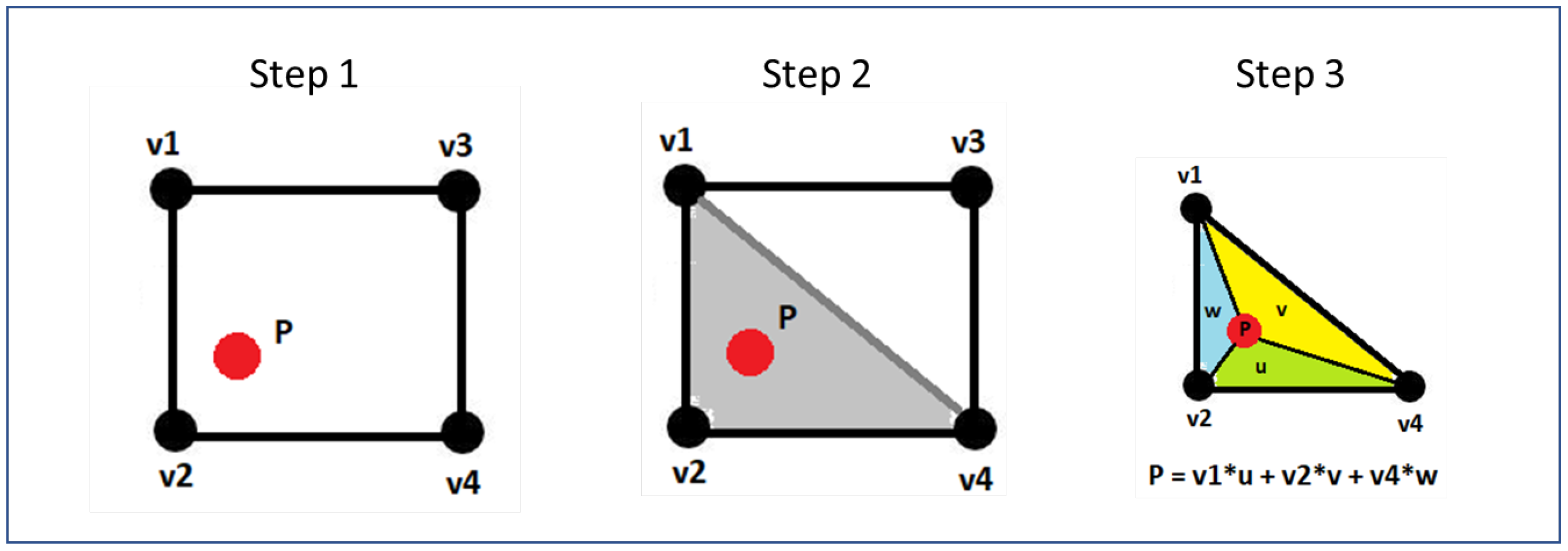


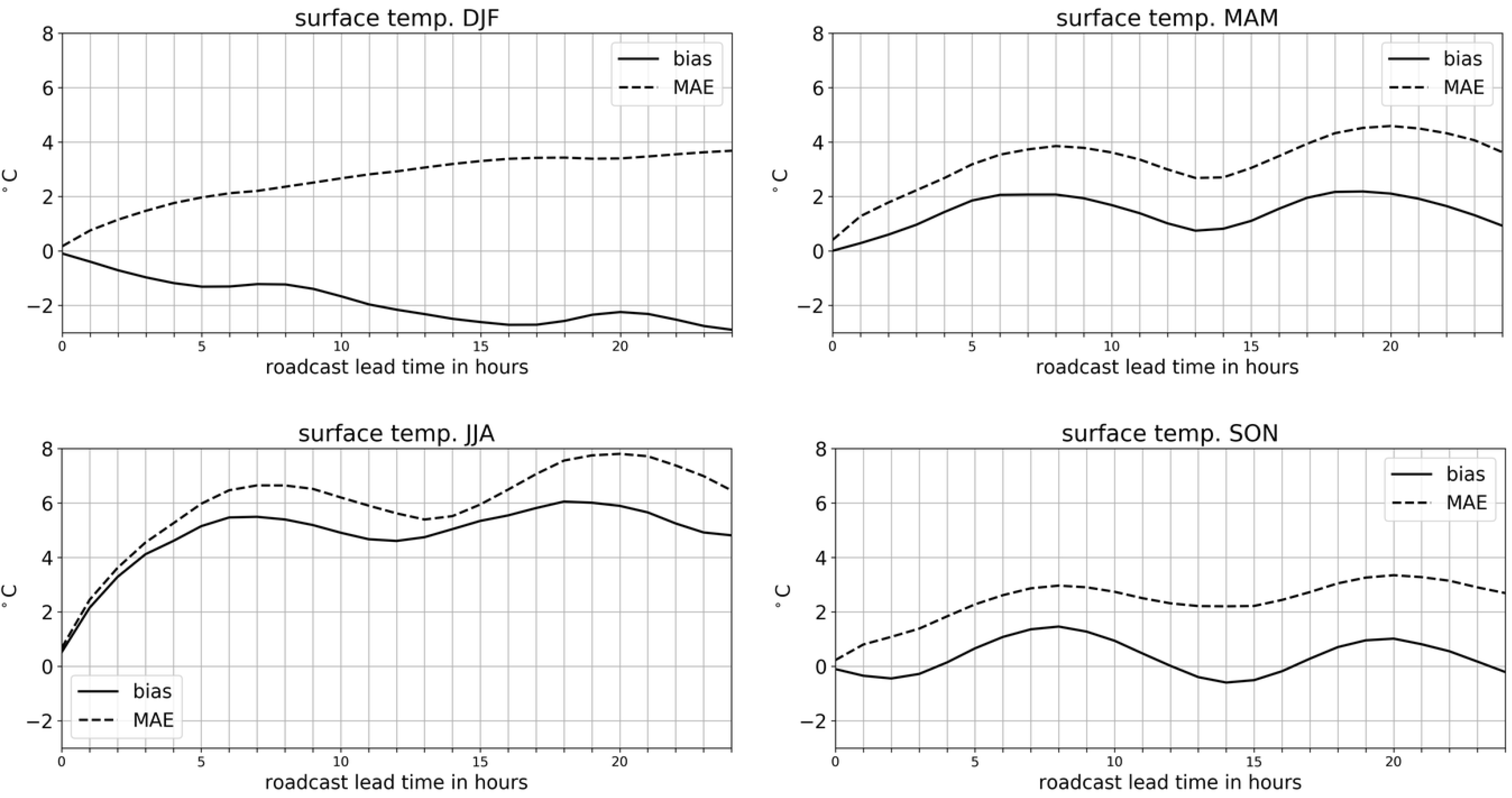
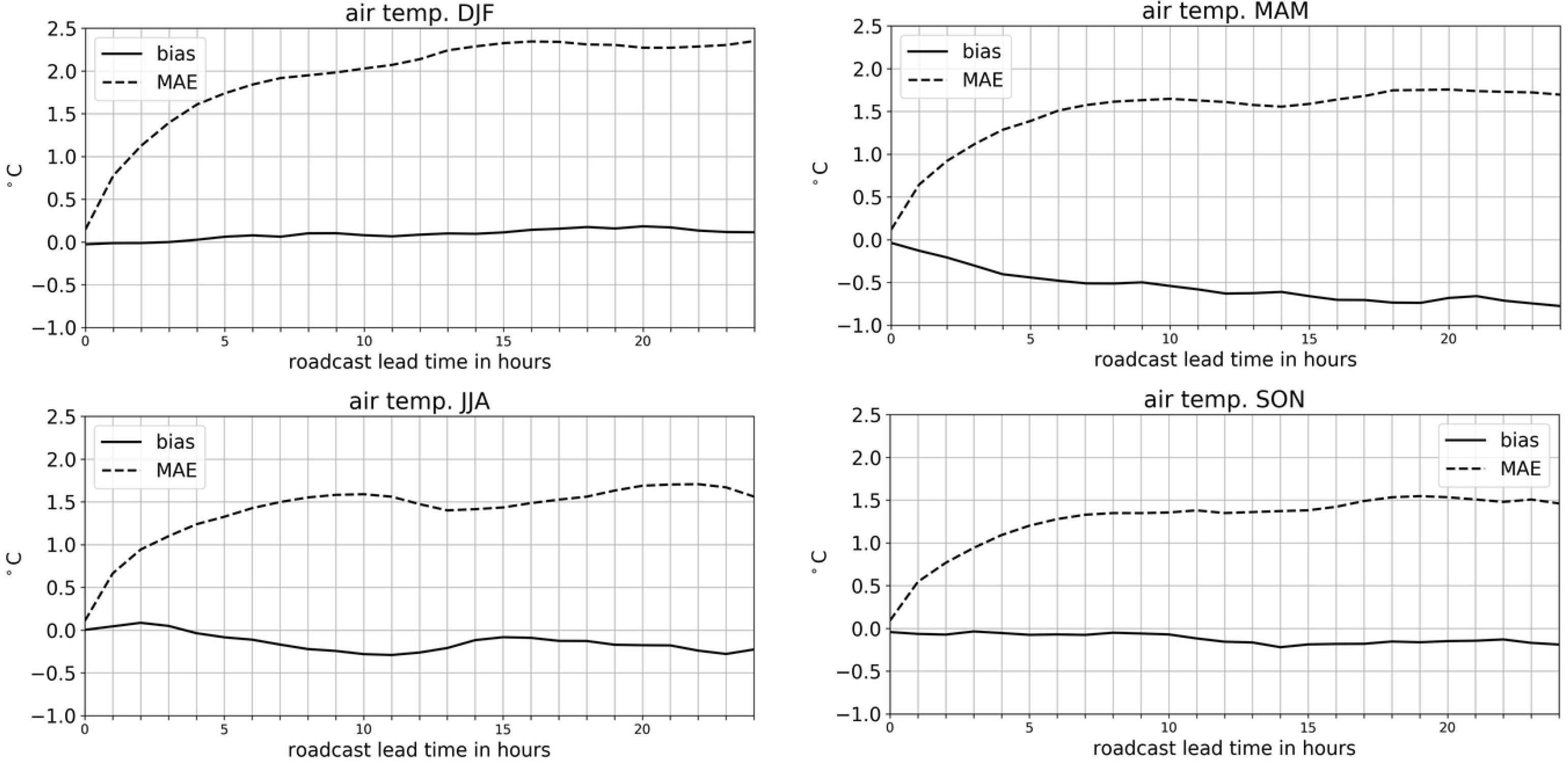
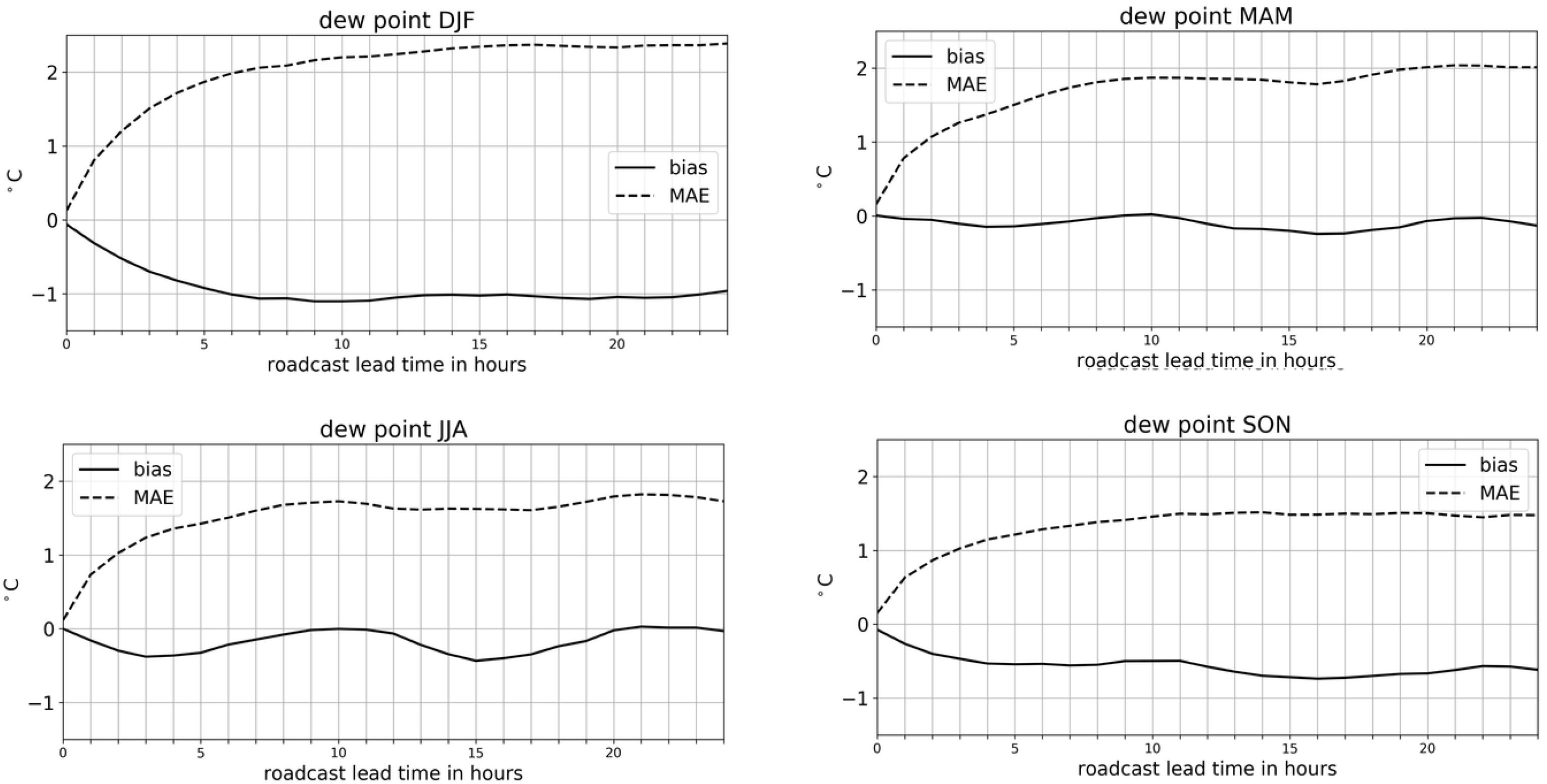

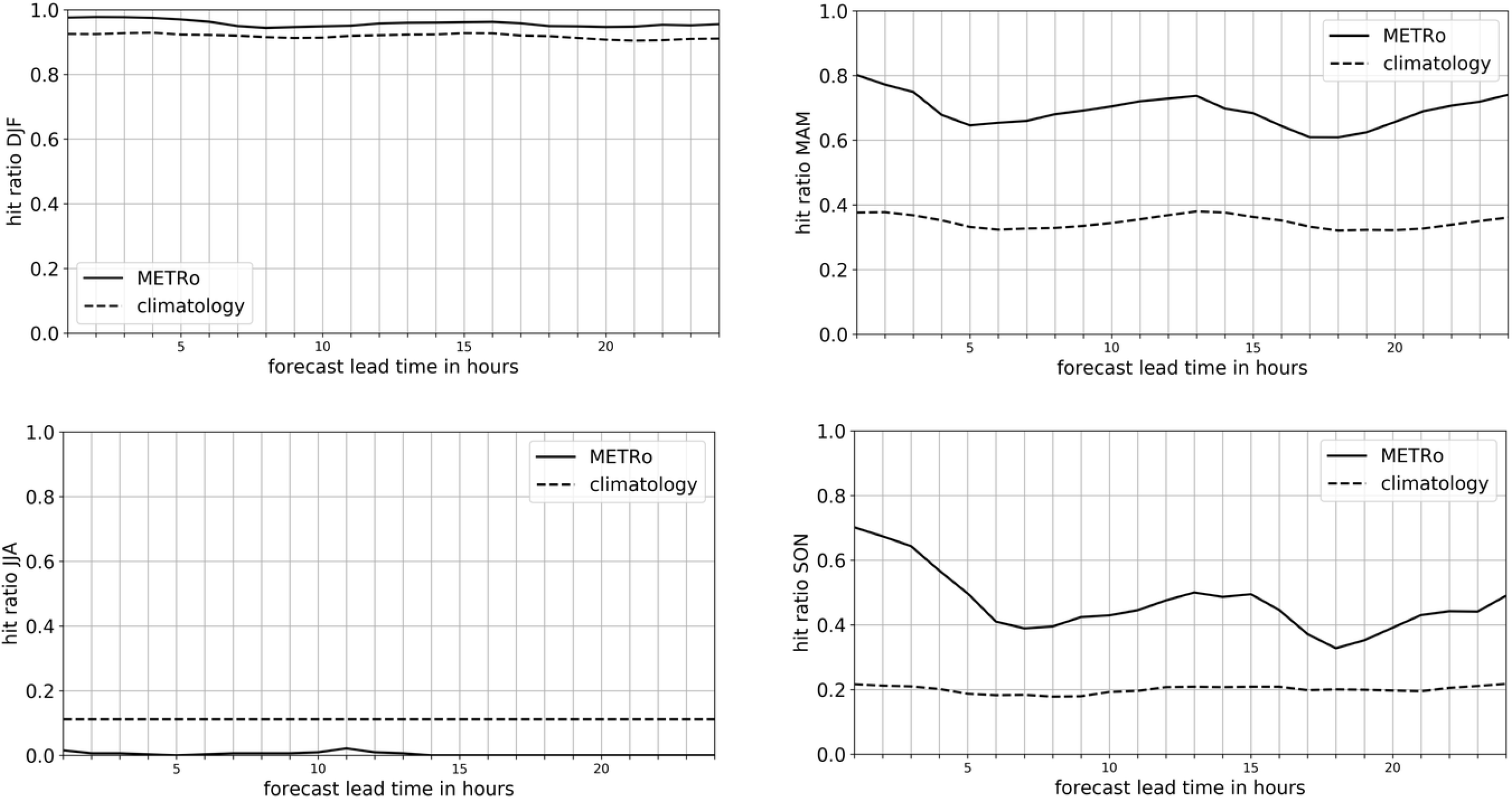

| Parameter | Description | Unit |
|---|---|---|
| altitude | height above sea level | m |
| air_temperature_2 m | screen level temperature | K |
| relative_humidity_2 m | screen level relative humidity | Normalized (0–1) |
| wind_speed_10 m | wind speed at 10 m height | m/s |
| cloud_area_fraction | total cloud cover | Normalized (0–1) |
| air_pressure_at_sea_level | air pressure at sea level | hPa |
| precipitation_amount | accumulated total precipitation | kg/m2 |
| Parameter Name | Parameter Description | Convertion Description | Availability in THREDDS | Unit |
|---|---|---|---|---|
| at | Air temperature at 1.5 m | present in THREDDS as air temperature at 2 m | Present | K |
| td | Dew point at 1.5 m | derived from relative humidity | Derived | K |
| ws | Wind speed at 10 m | wind speed at 10 m height | Present | m/s |
| cc | Octal cloud coverage | present in THREDDS as fractional cloud cover | Present | Normalized (0–1) |
| ap | Surface pressure at station altitude | calculated as explained in Table 1 | Not Present | hPa |
| ra | Rain precipitation quantity | derived from total precipitation | Not Present | kg/m2 |
| sn | Snow precipitation quantity | derived from total precipitation | Not Present | kg/m2 |
| METRo Parameter Name | Unit | Used THREDDS Parameters | Unit | Conversion Strategy |
|---|---|---|---|---|
| forecast time | ISO 8601 | time | s | Javascript function that returns a string in ISO format |
| at | °C | air_temperature_2 m (T) | K | |
| td | °C | dewpoint_temperature_2 m (T), relative_humidity_2 m (RH) | K | |
| ws | km/h | wind_speed_10 m | m/s | wind_speed_10 m |
| cc | octal (0–8) | cloud_area_fraction (C) | 0–1 | |
| ap | mbar | air_pressure_at_sea_level (P0), altitude (h) | hPa, m | |
| ra | mm | precipitation_amount (prec) | kg/m2 | if at > 0: ra = prec |
| sn | cm | precipitation_amount (prec) | kg/m2 | if at ≤ 0: sn = prec |
| Station ID | Long Name | Latitude | Longitude | Altitude [m] |
|---|---|---|---|---|
| SN27785 | E18 Rødbøl | 59.107 | 10.1062 | 83.7 |
| SN53280 | E16 Flåm | 60.861 | 7.1048 | 6.1 |
| SN63595 | Rv70 Gråura | 62.5818 | 9.2136 | 463.8 |
| SN79215 | E6 Yttervika | 66.2298 | 13.8728 | 9.8 |
| SN16611 | E6 Fokstugu | 62.1125 | 9.28625 | 976.8 |
| SN16620 | E6 Avsjøen | 62.1807 | 9.4752 | 929.8 |
| SN27055 | Fv312 Hanekleiva | 59.5735 | 10.181 | 75.1 |
| SN27075 | E18 Grelland | 59.511 | 10.2078 | 92 |
| SN27285 | E18 Gulli Nord | 59.3183 | 10.3748 | 26.4 |
| SN27730 | E18 Fokserød | 59.1828 | 10.2077 | 104.8 |
| SN50815 | E39 Vågsbotn | 60.4768 | 5.348 | 91.1 |
| SN6700 | Rv3 Svingen | 60.9573 | 11.4902 | 202 |
| SN67153 | E39 Øysand | 63.3237 | 10.2438 | 13.9 |
| SN68175 | E6 Moholtlia | 63.4078 | 10.4388 | 118 |
| SN79791 | E6 Saltfjellet | 66.5548 | 15.3235 | 673.9 |
| SN84770 | E6 Hålogalandsbrua | 68.4683 | 17.482 | 42.1 |
| SN84905 | E10 Bjørnfjell | 68.436 | 18.1035 | 502.2 |
| SN91490 | E8 Bossovarri | 69.1185 | 20.7455 | 544.8 |
| SN12280 | Rv3 Stabekken | 60.8165 | 11.2853 | 216.1 |
| SN27320 | E18 Hem Nord | 59.3535 | 10.3825 | 56.4 |
| SN49860 | Rv7 Dyranut | 60.3693 | 7.4945 | 1232.9 |
| SN52390 | E39 Ostereidet | 60.626 | 5.4722 | 96.6 |
| SN61580 | E136 Brustuglia | 62.2943 | 8.1255 | 452.1 |
| SN82210 | Rv80 Bertnes | 67.2878 | 14.5932 | 26 |
| SN84910 | E10 Skitdalshøgda | 68.516 | 17.8725 | 398.9 |
| SN6690 | Rv3 Ebru | 60.8632 | 11.4172 | 269 |
| SN91420 | E8 Halsebakkan Nedre | 69.2852 | 20.4657 | 153.9 |
Disclaimer/Publisher’s Note: The statements, opinions and data contained in all publications are solely those of the individual author(s) and contributor(s) and not of MDPI and/or the editor(s). MDPI and/or the editor(s) disclaim responsibility for any injury to people or property resulting from any ideas, methods, instructions or products referred to in the content. |
© 2025 by the authors. Licensee MDPI, Basel, Switzerland. This article is an open access article distributed under the terms and conditions of the Creative Commons Attribution (CC BY) license (https://creativecommons.org/licenses/by/4.0/).
Share and Cite
Andrade, F.A.A.; Lorenz, T.; Moura, M.; Spengler, T.; Feliciano, M.; Mayer, S. Road Weather Forecasts in Norway with the METRo Model. Meteorology 2025, 4, 16. https://doi.org/10.3390/meteorology4020016
Andrade FAA, Lorenz T, Moura M, Spengler T, Feliciano M, Mayer S. Road Weather Forecasts in Norway with the METRo Model. Meteorology. 2025; 4(2):16. https://doi.org/10.3390/meteorology4020016
Chicago/Turabian StyleAndrade, Fabio A. A., Torge Lorenz, Marcos Moura, Thomas Spengler, Manoel Feliciano, and Stephanie Mayer. 2025. "Road Weather Forecasts in Norway with the METRo Model" Meteorology 4, no. 2: 16. https://doi.org/10.3390/meteorology4020016
APA StyleAndrade, F. A. A., Lorenz, T., Moura, M., Spengler, T., Feliciano, M., & Mayer, S. (2025). Road Weather Forecasts in Norway with the METRo Model. Meteorology, 4(2), 16. https://doi.org/10.3390/meteorology4020016







